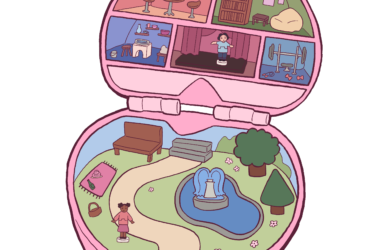 brittanica.com
brittanica.comAllie, now a 10-month-old tabby, was found as a kitten living with a group of squirrels. A Montreal family started feeding her but knew that when they moved, she would be out of luck, so they brought her to Eleven Eleven Animal Rescue where she was socialized and adopted to a loving home.
The Montreal rescue group—which takes in mostly feral kittens and pets that are about to be euthanized—has found families for more than 100 animals since Caroline Ross founded the organization. This number may sound impressive to some, but Ross knows that this is barely a scratch on the surface.
“The number of cats we saved in the past year is less than the number of cats euthanized just last week at the pound that we work with,” she says. “We rescued about 60 cats last year and in one day they had to euthanize 40 cats.”
These euthanasia rates are not unusual in Montreal, which struggles with an alarmingly high number of homeless cats. The Society for the Prevention of Cruelty to Animals shelter in Montreal takes in approximately 10,500 cats a year—with 150-250 cats living at the shelter on any given day—and euthanizes 50 per cent of the those admitted. There are hundreds of thousands of feral and abandoned cats roaming the city’s streets, and most cities in Quebec have done little to address the problem.
A large part of the problem comes from high rates of animal abandonment in the province. Some attribute this to a lingering agricultural mentality towards animals, in which pets are seen as disposable, while others blame the no pet clauses common in Quebec leases. Quebec’s annual moving day on July 1st has become a day dreaded by animal rescue workers; it is the peak of the moving season during which half of all abandoned animals in Quebec are left behind. This phenomenon is not seen in any other province.
“No-pet clauses are forbidden in Ontario leases, so you don’t have an issue of people moving and not being able to move with their animals,” explains Alanna Devine, director of animal welfare at the Montreal SPCA. “It’s also partly about attitude. Unfortunately, in Quebec, there are still a lot of people who don’t realize that owning an animal is a lifelong commitment to that animal and not just a convenience thing.”
These abandoned pets add to the growing number of cats animal rescue groups are trying to help. Taking cats into rescues and putting them up for adoption is often seen as the best way to help these cats, but lack of adopters make this unsustainable.
“Even if all cats were healthy at all times and were 100 per cent adoptable, it’s not about space—we’d be stacking cats on top of cats on top of cats—it’s about supply and demand,” says Devine. “There are too many cats and not enough homes.”
Smaller rescues, such as Eleven Eleven—which does not operate a shelter—rely completely on foster homes to house cats for adoption. However, the lack of foster parents limits the number of pets the group can save from euthanization. At the height of summer the group had 25 kittens in foster homes, but in one week received 80 emails asking the group to find homes for their cats, all of which had to be turned down.
“Even with all the effort we’re doing to save them, there’s still such a huge overpopulation,” says Ross. “The town that we work with, they’ve got the cage space for 20 cats and they get about 60 to 100 cats a week during the summer. So any cat that’s going to the pound is just going to get euthanized.”
Most of Montreal’s cats are not in shelters: they’re on the street. The feral cat population in Montreal is continuing to increase. When unneutered cats are unleashed on the streets—either abandoned or just let outdoors—they breed with homeless cats, creating an epidemic of street-born feral cats. On average, a breeding pair of feral cats will spawn 100 offspring within their short lives. Unlike strays, feral cats have lived on the streets their whole lives and are not used to humans. After four months of age it can be incredibly difficult to domesticate feral cats.
Until recently, the common way to deal with these cats was to trap them and take them to city shelters to be euthanized. But in recent decades, groups have been turning to Trap-Neuter-and-Release programs to slow the exponential growth of the feral cat population. One of the first TNR programs in North America was implemented by Stanford University in 1989 to deal with the more than 1,500 homeless cats living on their campus, and today the number is down to 200. Not only is the program touted as more humane for the cats, it has more support from citizens, and is supposed to combat the “vacuum effect” that removal programs ignore. Cats are highly territorial, but when feral cats are removed, new ones move in for food sources and the remaining cats breed at high levels until this environment can no longer support the population—this is the “vacuum effect.” One area has only enough food or space for shelter for a certain number of cats, and population of breeding cats will always be at this number, either by breeding or by cats moving in. But if cats are sterilized and returned, the population will stabilize and decrease as the cats stop reproducing while still protecting their territory from other strays.
However, TNR requires hard work and patience. Citizen involvement is required in locating and trapping cats. In order to stabilize a population within cat colonies, at least 70 per cent of the colony has to be sterilized, and this can take more than a year depending on the size of the population. From there it will take years for the colony to decrease.
But organizations around Montreal are taking up the challenge. The SPCA runs TNR programs in Verdun and Lachine—two municipalities that were in dire need of help over a year ago—while Steri-Animal does TNR throughout the Montreal area. In the past seven years Steri-Animal has successfully stabilized cat populations in at least 30 colonies. They currently sterilize around 140 feral cats a year as part of their TNR programs.
“Just last week there was a colony of 12 cats and we sterilized all 12,” says Linda Heimann, co-founder and director of operations for Steri-Animal. “Now that the cats are fixed the neighbours are no longer complaining because the cats are no longer wandering into their yards or peeing on their barbeques.”
Mike Cohen, city councillor for Côte St-Luc, noticed the problem of feral cats in his municipality and realized that someone needed to take action. After research and a public meeting on the issue in August, Cohen has now obtained council support for funding a TNR program in Côte Saint-Luc. Once the program’s budget has been determined, Cohen’s next step will be to enlist citizens willing to roll up their sleeves to help find and trap the cats.
“There’s no way in a million years that we could come up with the funding to track down every cat, but if there’s 10,000—and that’s the number that the vet’s given us—we’re going to try to trap as many as we can and as many as we can afford to pay for.”
This may sound expensive, but those in support of TNR point to its lower cost compared to euthanasia.
“Our average cost is $200 per animal that we take into [the SPCA],” says Devine. “Some animals spend five months here, some animals spend five days, some spend five minutes—it’s really dependent upon an average figure. So if you look at that versus how much it costs to sterilize a cat, then yes it’s less expensive.”
In the long run, Devine says, TNR programs reduce the number of animals coming in, thereby decreasing costs over time.
But is this just soft-hearted idealism? Some argue that TNR is nicer for the people dealing with homeless cats than it is for the cats. Feral cats have more difficult and shorter lives than domesticated cats. On average, a house ca
t that is not allowed outside will live two to three years longer than those allowed outdoors, due to the inherent dangers outside. A feral cat has an average lifespan of only two years if it lives by itself, and five years in a colony, compared to 15-22 years for an indoor cat. Although spaying a female cat takes away the burden of delivering two litters a year, and neutered males are less likely to fight and spread injury and disease, even cared-for TNR cats face potentially painful ends.
“A lot of them are killed by cars,” says David Bird, professor of wildlife biology at McGill University. “You’ve got predators like coyotes that are coming into towns now more and more, and other predators like dogs and foxes. And on top of that you have to worry about nasty people out there who do not like cats running loose.”
Bird, a former cat owner, argues that TNR is not a practical solution for decreasing the homeless cat population, and is instead the easy way out of a difficult situation.
“I find catching and euthanizing cats distasteful too … But what’s more humane? You put them out there and have them eke out an existence, eating a lot of birds and living at the mercy of predators, bad weather, disease, all kinds of stuff,” he says. Ultimately, Bird feels putting them to sleep is more humane.
There is further controversy over whether TNR actually prevents the vacuum effect. Some studies have shown that cats around the feeding stations are not overly territorial, allowing feral cats from all around to converge at feeding areas. This may also lead to people dumping their unwanted cats at feeding locations, knowing that they’ll have food and be less likely to be euthanized than at a shelter. Yet the majority of studies in the United States and Europe, where TNR projects have been in place for much longer, have shown the program to be a success.
“For cats who have been abandoned, life on the streets can be very hard, but feral cats cannot be adopted. Who are we to say a cat has to be euthanized because it doesn’t have a home? The cats are healthier after we spay them; they don’t get sick [as much], they don’t fight,” says Heimann.
But in the end, TNR advocates and opponents both want the same thing: for the number of homeless cats to decrease. And as Devine says, “The options are: you can trap and kill, you can do nothing, or you can do TNR. The first two have been done in Montreal for years and years and the problem isn’t going away, so I think we need to look at a different alternative.”
TNR programs cannot work if people are letting unfixed animals roam around, or if they’re throwing their unwanted cats out on the street. One way to help limit this kind of irresponsibility is through low-cost spay/neuter initiatives. In 2008, Steri-Animal joined with the SPCA to start Operation Feline, a low-cost spay/neuter clinic to help decrease the number of unfixed cats and increase the amount of people able to afford these basic clinic services. Unfortunately, because of Quebec Veterinary Medicine Association (AMVQ) laws which prohibit veterinary clinics from being owned by non-veterinarians, the program had to rely on the donated time and goodwill of vets throughout Montreal. Due to a lack of voluntary vets willing to donate one day a year, Operation Feline was forced to close, but Steri-Animal still runs low-cost sterilization services through the four vets they work with.
“I sort of expected that there would be a lot more vets willing to contribute, but that’s not the case,” says Heimann. “[Low-cost spay/neuter programs] are dependent on the goodwill of the vets in the city, and there just aren’t that many who are interested in participating.”
As different municipalities start to look at the cat overpopulation on their streets, thought needs to be given not just to TNR, but to fundamental changes in the laws that affect pet owners in Montreal.
“We’re fighting an unwinnable battle unless we change our strategy. We need to address the root causes,” Devine says, “I think it comes down to education, access to affordable spay/neuter surgeries, municipal legislation that outlaws having no-pet clauses in our leases, and stricter legislation to really promote responsible pet ownership, such as initiatives to make spay/neuter mandatory for people who aren’t responsible with their pet.”
As a student, one of the biggest ways you can help Montreal cats is by fostering. When you foster, you agree to provide a home for a cat or kitten and care for it until it gets adopted. Rescues pay for food, vet bills, etc., so while the cat is in your care, you get all of the benefits of having a pet, without the cost or 15-year commitment. And you’re saving a life.
Montreal SPCA:
Foster animals are often those that are too young to be adopted or ones needing minor medical treatment (e.g. ear drops) or behavioural work before being put up for adoption. Call (514) 735-2711 x2237 or go to spcamontreal.com/aidez3.php?lg=en for more information.
Eleven Eleven
Animal Rescue:
Specializing in feral kittens, foster animals are often young cats who are in need of basic socialization. Dogs and cats about to be euthanized for unnecessary reasons also need foster homes, but they can’t be saved if there are no homes available. Go to elevenelevenanimalrescue.org/Fostering.html.
Steri-Animal:
Kittens less than 12 weeks old that are caught in the TNR program are placed in foster homes to be socialized and re-homed. Helps keep the homeless cat population down and cats out of shelters. Fill out a form at steri-animal.org/ENFosterForm.html.
Animal Rescue Network:
This cat rescue needs foster homes for cats with special needs, such as special diets (food is provided), pregnant cats, senior cats, or cats with FIV (a feline auto-immune disease not contagious to people). Email [email protected] or go to animalrescuenetwork.org/info/display?PageID=989 to find out more.







